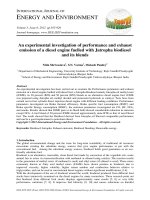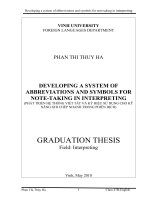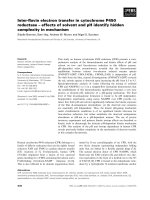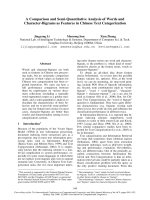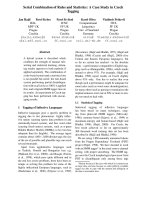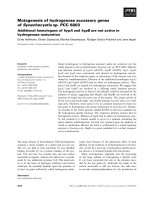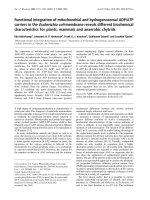Resource investigation of low and moderate temperature geothermal areas in san bernardino
Bạn đang xem bản rút gọn của tài liệu. Xem và tải ngay bản đầy đủ của tài liệu tại đây (19.88 MB, 271 trang )
CALIFORNIA DEPARTMENT OF CONSERVATION
DIVISION OF MINES AND GEOLOGY
DMG OPEN-FILE REPORT 82-11
RESOURCE INVESTIGATION OF
LOW - AND MODERATE-TEMPERATURE
GEOTHERMAL AREAS IN
SAN BERNARDINO, CALIFORNIA
1981
THE RESOURCES AGENCY
STATE OF CALIFORNIA
DEPARTMENT OF CONSERVATION
GORDON K. VAN VLECK
SECRETARY FOR RESOURCES
GEORGE DEUKMEJIAN
GOVERNOR
RANDALL M. WARD
DIRECTOR
DIVISION OF MINES AND GEOLOGY
BRIAN E. TUCKER
ACTING STA TE GEOLOGIST
RESOURCE INVESTIGATION OF
LOW- AND MODERATE-TEMPERATURE GEOTHERMAL AREAS IN
SAN BERNARDINO, CALIFORNIA
Part of the Third Year Report, 1980-81, of the
U.S. Department of Energy-California State-Coupled Program
for
Reservoir Assessment and Confirmation
by
Leslie G. Young~/
Stephen P. Bezore ~/
Rodger H. Chapman
1/
Gordon W. Chas~/
August, 1981
This work was performed under Grant No. DE-FG03-80SFl0855
for the U.S. Department of Energy, Division of Geothermal Energy,
by the California Department of Conservation,
Division of Mines and Geology.
1/ Geologist/Geophysicist, California Division of Mines and Geology
2/ Geologist, California Division of Mines and Geology
3/ Geophysicist, California Division of Mines and Geology
~"1.
A
FJ
(/\::,.,.
i~
C1
9
.
b •
~
i
ABSTRACT
Resource Investigation of Low- and Moderate-Temperature
Geothermal Areas in San Bernardino, California
The
California Division of Mines and Geology
Bernardino
area
was
contained
area
known
a
for
to
large
detailed geothermal resource
contain
promising
population
center,
geothermal
and
the
(CDMG)
selected
the San
investigation because
resource
City
of
sites,
the
San Bernardino
the
area
had
expressed serious interest in developing the area's geothermal resource.
Ninety-seven geothermal wells and springs were identified and plotted on
a compiled geologic map of the 40-square-mile study area.
These wells and
springs were concentrated in three distinguishable resource areas:
Arrowhead
Hot Springs; South San Bernardino; and Harlem Hot Springs -- in each of which
detailed geophysical, geochemical, and geological surveys were conducted.
The
Arrowhead Hot Springs geothermal area lies just north of the City of San Bernardino in the San Bernardino Mountains astride a shear zone (offshoot of the
San Andreas fault) in pre-Cambrian gneiss and schist.
The Harlem Hot Springs
geothermal area, on the east side of the City, and the south San Bernardino
geothermal area, on the south side, have geothermal reservoirs in Quaternary
alluvial material which overlies a moderately deep sedimentary basin bound on
the southwest by the San Jacinto fault
(a ground water barrier).
Geother-
l!l0metry calculations suggest that the Arrowhead Hot Springs geothermal area,
with a maximum reservoir temperature of 142°C, may have the highest maximum
reservoir temperature of the three geothermal areas.
. ii
The maximum temperature
recorded by CDMG in the south San Bernardino geothermal area was 56°C from an
artesian well,
while
the maximum temperature
recorded
in
the
Harlem Hot
Springs. geothermal area was 49.5°C at 174 meters (570 feet) in an abandoned
water well.
The geophysical and geological surveys delineated fault traces in association with all three of the designated geothermal areas.
revealed a heretofore unmapped,
east-west
Harlem Hot Springs geothermal area.
trending fault
The gravity survey
that bisects the
The dipole-dipole resistivity survey sug-
gested a more refined location of a segment of the Loma Linda fault, slightly
to the southwest of the previously reported location in the South San Bernardino geothermal area.
Interpretation of data from the geophysical, geologi-
cal, and geochemical surveys and from temperature data indicates the presence
of a major geothermal fluid up-welling, or "plume", along this segment of the
Loma Linda fault.
The data also suggest that other geothermal fluid "plumes"
in association with faulting are present within the three designated geothermal areas.
iii
•
PREFACE
This report presents the results of the California Division of Mines and
Geology's (CDMG) geothermal resource investigation of the San Bernardino area,
California.
The project was conducted in compliance with the terms of the
third year contract (1980-81) with the
the state-coupled program.
u.S.
Department of Energy (DOE) under
The investigation was performed under CDMG's Phase
I I site-specific geothermal resources studies program.
Phase I I type studies
involve the generation of new data and evaluation and interpretation of the
data to make quantitative and qualitative statements about the resource potential of a given geothermal reservoir.
The purpose of the study was to determine the low- to moderate-temperature geothermal energy potential of the many known "hot"
water wells and
several hot springs occurring in or very near the San Bernardino area.
A
low- to moderate-temperature geothermal resource in association with an urban
center suggests many potential uses of the resource.
The City of San Bernar-
dino, which has a population of approximately 117,000 according to the 1980
census, and other local government agencies have expressed interest in utilizing the geothermal resource.
This is particularly true of the City of San
Bernardino Municipal Water Department.
Concern over
dwindling
fossil
fuel
supplies
and
interest
in finding
alternate forms of energy in recent years has been responsible for renewed
activity
in
efforts
aimed
at
utilization of low- and moderate-temperature
geothermal resources statewide.
The City of San Bernardino Municipal Water
Department, recognizing this trend, is currently undertaking a project to use
iv
the geothermal resource at San Bernardino to heat the sludge digester at their
waste water treatment plant.
studies
to
determine
the
They are also currently conducting feasibility
possibility
of
establishing
a
municipally
owned
direct-use geothermal heating district in San Bernardino.
Historically, the geothermal resources at San Bernardino have been considered as a benefit for health and recreation uses and as a nuisance in any
ground water development project.
Health spas
sites.
and amusement
When water
tables
parks were erected at original hot
lowered as
population and
springs
agricultural usage
of
ground water increased, wells were drilled into the old hot springs to keep
geothermal water supplies available to the spas and parks.
and
amusel1lent
larity.
parks
eventually
succumbed to progress and a
The health spas
loss
of
popu-
Most were closed and abandoned by the 1930's.
Increasing
agricultural
growth
and,
later,
greater demand for fresh ground water supplies
urban
at
expansion
created
San Bernardino.
In
a
the
quest for sufficient fresh water, more and deeper water wells were drilled.
Geothermal ·water-bearing aquifers were sometimes encountered during drilling.
The hot water generally made these wells useless as a
fresh water supply.
Great effort was made to backfill wells to seal off the "hot" water aquifers.
Many wells were eventually abandoned because the water was too hot or too
mineralized for agricultural or domestic uses.
Once
considered a
nuisance,
the
abandoned geothermal resources at San
Bernardino are now being considered as a viable alternate energy source for
the area.
v
TABLE OF CONTENTS
Page
ABSTRACT. • • • • • • • • • • • • • • • • • • • • • • • • • • • • • • • • • • • • • • • • • • • • • • • • • • • • • • • •
ii
PREFACE..........................................................
iv
LIST OF TABLES...................................................
LIST OF FIGURES..................................................
LIST OF PLATES...................................................
xi
INTRODUCTION. •• • • • • • • • • • • • • • • • • • • • • • • • • • • • • • • • • • • • • • • • • • • • • • • • • • •
1
x
xv
DEVELOPMENT OF THE GEOTHERMAL RESOURCES OF THE
SAN BERNAR.DINO
AR.EA..............................................
Introduction................................................
Development of the Hot Springs..............................
Arrowhead Hot Springs...................................
3
3
4
4
Waterman Hot Springs....................................
13
Urbita Hot Springs......................................
17
Springs...........................
19
Harlem Hot Springs......................................
20
Rabel Hot Springs.......................................
Development of Geothermal Wells.............................
Current Geothermal Usage....................................
21
Conclusions.................................................
26
De Sienna (Siena) Hot
AREAL EXTENT OF GEOTHERMAL RESOURCES IN THE SAN
BERNARDINO AREA,
24
25
CALIFORNIA......................................
28
Introduction •••••••••••••••••••• ~..................... ••••••
28
Methodology.................................................
Results.....................................................
Arrowhead Hot Springs Geothermal Area...................
Harlem Hot Springs Geothermal Area......................
South San Bernardino Geothermal Area....................
Discussion..................................................
28
vi
29
29
30
31
32
Page
GEOLOGIC SETTING •••••••••••••••••••••••••••••••••••••••••••••••••
34
Introduction ••••••••••••••••••••••••••••••••••••••••••••••••
34
Basement Rocks ••••••••••••••••••••••••••••••••••••••••••••••
34
Tertiary Deposits •••••••••••••••••••••••••••••••••••••••••••
Quaternary Deposits •••••••••••••••••••••••••••••••••••••••••
36
37
Structure •••••••••••••••••••••••••••••••••••••••••••••••••••
39
DETAILED GEOTHERMAL AREA GEOLOGy •••••••••••••••••••••••••••••••••
Arrowhead Hot Springs Geothermal Area •••••••••••••••••••••••
41
41
Harlem Hot Springs Geothermal Area ••••••••••••••••••••••••••
42
South San Bernardino Geothermal Area ••••••••••••••••••••••••
44
HYDROLOGY ••••••••••••••••••••••••••••••••••••••••••••••••••••••• '.
46
Introduction ••••••••••••••••••••••••••••••••••••••••••••••••
46
Water-Bearing Deposits ••••••••••••••••••••••••••••••••••••••
47
San Jacinto Fault - The "Bunker Hill Dike ................... .
48
GEOPHYSICAL INVESTIGATIONS •••••••••••••••••••••••••••••••••••••••
50
50
50
Introduction ••••••••••••••••••••••••••••••••••••••••••••••••
Ground Magnetic Survey ••••••••••••••••••••••••••••••••••••••
Equipment and Procedure •••••••••••••••••••••••••••••••••
Interpretation of Data ••••••••••••••••••••••••••••••••••
51
51
South San Bernardino Geothermal Area ••••••••••••••••
51
Harlem Hot Springs Geothermal Areas •••••••••••••••••
57
Arrowhead Hot Springs Geothermal Area •••••••••••••••
57
Gravity Survey ••••••••••••••••••••••••••••••••••••••••••••••
60
Equipment and Procedure •••••••••••••••••••••••••••• ~ ••••
61
Gravity
••••••••••••••••••••••••••••••••••••••••••••
61
Regional and Residual Gravity Maps ••••••••••••••••••
61
Dat~
Local Gravity Anomalies - South San
Bernardino Geothermal Area ••••••••••••••••••••••••
62
Local Gravity Anomalies - Harlem
Hot Springs Geothermal Areas ••••••••••••••••••••••
vii
62
Page
Electrical Resistivity Survey •••••••••••••••••••••••••••••••
67
Equipment and Field Procedure •••••••••••••••••••••••••••
68
VES Data ••••••••••••••••••••••••••••••••••••••••••••••••
83
Dipole-Dipole Data ••••••••••••••••••••••••••••••••••••••
84
Interpretation of Resistivity Data ••••••••••••••••••••••
87
South San Bernardino Geothermal Area ••••••••••••••••
87
Harlem Hot Springs Geothermal Areas •••••••••••••••••
92
Conclusions •••••••••••••••••••••••••••••••••••••••••••••••••
93
SEISMICITY OF THE SAN BERNARDINO AREA, CALIFORNIA ••••••••••••••••
Epicenter Locations •••••••••••••••••••••••••••••••••••••••••
95
95
96
Discussion ••••••••••••••••••••••••••••••••••••••••••••••••••
104
Summary •••••••••••••••••••••••••••••••••••••••••••••••••••••
107
GEOCHEt-1ISTRY •••••••••••••••••••••••••••••••••••••••••••••••••••••
108
108
Introduction ••••••••••••••••••••••••••••••••••••••••••••••••
Introduction ••••••••••••••••••••••••••••••••••••••••••••••••
Results •••••••••••••••••••••••••••••••••••••••••••••••••••••
108
111
Discussion ••••••••••••••••••••••••••••••••••••••••••••••••••
112
GEOTHERMOMETRY •••••••••••••••••••••••••••••••••••••••••••••••••••
114
Introduction ••••••••••••••••••••••••••••••••••••••••••••••••
114
115
Methodology •••••••••••••••••••••••••••••••••••••••••••••••••
Methodology ••••••••••••••••••••••••••••••••••• ~ ••••••• ••••••
Discussion ••••••••••••••••••••••••••••••••••••••••••••••••••
116
117
DIRECT TEMPERATURE MEASUREMENTS OF THE SAN BERNARDINO
GEOTHER.MA.L AREAS •••••••••••••••••••••••••••••••••••••••••••••••••
120
Results •••••••••••••••••••••••••••••••••••••••••••••••••••••
Methodology •• '••••••••••••••••••••••••••••••• ~ •••••••••••••••
120
120
Resul ts •••••••••••••••••••••••••••••••••••••••••••
121
Introduction ••••••••••••••••••••••••••••••••••••••••••••••••
0• • • • • • • • • •
Arrowhead Hot Springs Geothermal Area •••••••••••••••••••
122
Harlem Hot Springs Geothermal Areas •••••••••••••••••••••
122
126
South San Bernardino Geothermal Area ••••••••••••••••••••
viii
Page
ASSESSMENT OF THE GEOTHERMAL RESOURCES AT SAN
BERNARDINO,
CALIFORNIA .......................................... .
Introduction ••••••••••••••••••••••••••••••••••••••••••••••••
129
129
Properties of the Resources Areas •••••••••••••••••••••••••••
129
Arrowhead Hot Springs Geothermal Area •••••••••••••••••••
130
Harlem Hot Springs Geothermal Areas •••••••••••••••••••••
131
South San Bernardino Geothermal Area ••••••••••••••••••••
133
Geothermal Resources Model ••••••••••••••••••••••••••••••••••
136
Conclusions •••••••••••••••••••••••••••••••••••••••••••••••••
139
ACKNOWLEDGMENTS ••••••••••••••••••••••••••••••••••••••••••••••••••
142
CITED .................................................
APPENDIXA GEOCHEMISTRY ANALySIS...............................
APPENDIX B TEMPERATURE LOGS....................................
APPENDIX C - GEOLOGIC LOGS.......................................
143
189
SELECTED REFERENCES FOR THE SAN BERNARDINO AREA,
CALIFORNIA, GEOTHERMAL RESOURCE
233
REFERENCES
AREAS..........................
ix
147
170
LIST OF TABLES
Page
Table 1.
A comparison of recorded temperatures at
Arrowhead Hot Springs by CDMG, 1980-81 and
Bailey, 1910........................................... 12
Table 2.
Earthquake data for the San Bernardino
Area, Ca1ifornia-1900-1974 •••••••••••••••••••••••••••••
Table 3.
97
Geochemistry data for 13 water wells
sampled during the CDMG (1980-81) geothermal
investigation of the San Bernardino Area,
California ••••••••••••••••••••••••••••••••••••••••••••• 110
x
LIsr OF FIGURES
Page
Frontispiece. City of San Bernardino - 1871..........................
Figure
1.
The Arrowhead Springs sanitarium facility
and adjoining pond in 1883..............................
Figure
2.
i
5
Advertisement for the Arrowhead Hot Springs
resort from the 1887 San Bernardino City
and County Directory. . . . . . . . . . . . . . . . . . . . . . . . . . . . . . . . . . . .
Figure
3.
Advertisements for two developed hot springs
in the City of San Bernardino (1908)....................
Figure 4.
5.
6.
7.
8.
9.
52
Ground magnetic traverse SBM-3 (Harlem Hot
Springs geothermal areas)...............................
Figure
35
Ground magnetic traverse SBM-l (south San
Bernardino geothermal area).............................
Figure
23
Location map of the San Bernardino study
area showing faults, geomorphic features,
and lly'drolc:x:Jic resins...................................
Figure
11
Advertisement for the Base Line laundry
(Octo'ber 12, 1947) ..... ~ . . . . . . . . . . . . . . . . . . . . . . . . . . . . . . . .
Figure
8
Recorded temperature in the "Granite Hot
Spring" at Arrowhead Hot Springs .••.••••••••••••.•••••••
Figure
7
Ground magnetic traverse
S~6
(Harlem Hot
Springs geothermal areas)...............................
xi
53
54
Page
Figure 10.
Ground magnetic traverse SBM-5 (Arrowhead
Hot Springs geothermal
Figure 11.
55
Ground magnetic traverse SBM-12 (Arrowhead
Hot Springs geothermal
Figure 12.
area)............................
area) ............................
56
Composite geophysical anomaly map of a portion of the south San Bernardino geothermal
area....................................................
Figure 13.
58
Composite geophysical anomaly map of portions of the Harlem Hot Springs geothermal
areas ...................................................
Figure 14.
Gravity profiles G-1 and G-4, Harlem Hot
Springs geothermal
Figure 15.
areas ................................
64
Gravity profiles G-2 and G-3, Harlem Hot
Springs geothermal
Figure 16.
59
areas................................
65
Interpretation of gravity profile G-1,
areas .....................
66
Figure 17.
Vertical Electric Sounding VES-1........................
70
Figure 18.
Vertical Electric Sounding VES-3 ••••••••••••••••••••••••
71
Figure 19.
Vertical Electric Sounding VES-4 ••••••••••••••••••••••••
72
Figure 20.
Vertical Electric Sounding VES-5 ••••••••••••••••••••••••
73
Figure 21.
Vertical Electric Sounding VES-6 ••••••••••••••••••••••••
74
Figure 22.
Vertical Electric Sounding VES:-7........................
75
Harlem Hot Springs geothermal
xii
Page
Figure 23.
Vertical Electric Sounding VES-8........................
76
Figure 24.
Vertical Electric Sounding VES-9........................
77
Figure 25.
Vertical Electric Sounding VES-10.......................
78
Figure 26.,
Vertical Electric Sounding VES-ll.......................
79
Figure 27.
Vertical Electric Sounding VES-12 •••••••••••••••••••••••
80
Figure 28.
Location map of electrical resistivity surveys, south San Bernardino geothermal area ••••••••••••••
Figure 29.
Location map of electrical resistivity surveys, Harlem Hot Springs geothermal areas •••••••••••••••
Figure 30.
82
Dipole-dipole line DDl pseudo-section and
interpretation ••••••••••••••••••••••••••••••••••••••••••
Figure 31.
81
85
Dipole-dipole line DD2 pseudo-section and
interpretation ••••••••••••••••••••••••••••••••••••••••••
86
Figure 32.
Electrical resistivity section A-A' •••••••••••••••••••••
89
Figure 33.
Electrical resistivity section B-B' •••••••••••••••••••••
90
Figure 34.
Heat flow anomaly across the San Jacinto
Fault near Anza, California ••••••••••••••••••••••••••••• 106
Figure 35.
Temperature profiles from water wells owned
by Patton State Hospital, San Bernardino,
California •••••••••••••••••••••••••••••••••••••••••••••• 124
xiii
Page
Figure 36.
Temperature profiles from two water wells
owned by East San Bernardino County Water
District, San Bernardino, California •••••••••••••••••••• 125
Figure 37.
Temperature profiles from water wells
located in the central portion of the
south San Bernardino
Figure 38.
geotherma~
area •••••••••••••••••••• 127
Diagrammatic cross-section of the geothermal reservoirs of the San Bernardino
Area, California •••••••••••••••••••••••••••••••••••••••• 137
xiv
LIST OF PLATES
Plate 1.
Geologic Map of San Bernardino, California and vicinity
with geothermal wells and springs.
Plate 2.
Hydrologic cross-section of the Bunker Hill basin.
Plate 3.
Water table
elevation and historic limits of artesian
zone in the San Bernardino Area, California.
Plate 4.
Location map of ground magnetic
traverses
in
the
San
half
San
Bernardino Area, California.
Plate 5.
Complete
Bouguer
Bernardino,
gravity map
California
eastern
one
and western one half
Redlands,
California, 15 minute quadrangles.
Plate 6.
Map
of
hydrological
features
and
selected wells
with
gravity contours for the San Bernardino Area, California.
Plate 7.
Epicenter
Bernardino,
locations
for
California
the
eastern
and western one
one
half' San
half
Redlands,
California 15 minute quadrangle - 1900-1974.
Plate 8.
Na-K-Ca geothermometry map for the San Bernardino area,
California.
xv
INTRODUCTION
The purpose of this study is to provide insight into the properties of
the geothermal resources at San Bernardino.
Areal extent, depth, maximum tem-
perature, volume, and water quality are properties that must be ascertained
before
effective
and economical
development
ture geothermal resource is undertaken.
of a
low- or moderate-tempera-
This report outlines the steps taken
to accomplish this end and presents results, conclusions, and recommendations
obtained from the study.
of
the
resource,
Included are new studies of historical development
detailed and regional
surveys, regional seismicity study,
of
geochemical
sampling
springs in the area.
and
geophysical
geothermometry calculations,
and results
measuring
of geothermal wells
and
Valuable down-hole geothermal well data is included in
the appendixes of this report.
references.
investigations,
temperature
geology
At the end of the report is a list of selected
The list contains 126 entries of geological, hydrological,
geo-
physical, geochemical, and geothermal studies of the San Bernardino area.
The
reference list should prove useful for finding further geotechnical information about the area.
This report presents a wealth of new material as well as a compilation of
previously performed studies singularly assembled for the purpose of investigating the geothermal resources of the San Bernardino area.
be useful in a number of ways.
The report should
Firstly, data presented and conclusions drawn
from the data provide a direct insight into .the physical and geochemical character of the geothermal resources of San Bernardino.
This report is perhaps
the first major work to be wholly focused on investigating these geothermal
resources.
Secondly, the report serves as a
1
source of geothermal data that
could be analyzed in different ways by other geothermal resource investigators.
For instance, other geothermometry calculations' than the Na-K-Ca geo-
thermometer (Fournier and Truesdell, 1973 and Fournier and Potter, 1978) may
be applied to the geochemical data in Appendix A.
A different geologic and
hydrologic cross-section than the one presented on Plate 2 may be constructed
from the geologic well logs in Appendix C.
Or perhaps some useful information
may be obtained by calculating temperature gradients from the down-hole temperature logs in Appendix B.
And thirdly, this report can serve as a refer-
ence for some low- and moderate-temperature geothermal investigative techniques complete with ,an evaluation of their effectiveness in the San Bernardino
geothermal resource assessment area.
This report may be the first comprehensive detailed geothermal study of
the San Bernardino area, but it is not meant to be the last geothermal study
of the area.
Concepts and conclusions arrived at in this report should be
continually revised, modified, and upgraded as new data from other researchers
are developed for the geothermal resources at San Bernardino.
2
DEVELOPMENT OF THE GEOTHERMAL RESOURCES
OF THE SAN BERNARDINO AREA
Introduction
One of the the major and least expensive elements of a geothermal resource area evaluation program should be the researching and compiling of the
historic development of that resource.
This is an especially applicable ex-
ploration technique of low- and moderate-temperature geothermal resource areas
of California.
Most often, in the past, California's warm or hot springs were developed
as resort spas or tuberculosis sanitariums where guests arrived for relaxation
and to take "the treatments".
As a result much literature has survived from
that era advertising and extolling the chemical and physical properties of
various hot springs.
A search of such material and other information can
yield valuable clues to the past character of a particular geothermal area.
Areal extent of the resource, changes in flow rates over the years, changes in
water quality, changes in temperature, and changes in hot water table evaluations can often be discerned from the historical record of a geothermal area.
The City of San Bernardino area ·at one time contained six developed "hot
springs".
There is much historic
literature available for
"springs" and little available for the others.
some of
these
The geothermal historic record
of the area is not only augmented with material written about these "springs",
but also by early ground water investigations and reports.
3
Development of the Hot Springs
Arrowhead Hot Springs
The Arrowhead Hot Springs are located on the south flank of the San
Bernardino Mountains slightly less than 10 km (6.3 miles) north of the center
of the City of San Bernardino (Plate 1, Locations No. 3-7).
The springs and
wells at Arrowhead Hot Springs are generally located in a narrow band along a
small mesa or plateau and in an adjoining narrow gully or canyon.
One of the earliest recorded accounts of temperature and flow rate at
Arrowhead Hot Springs is from Blake (1856):
"Around the borders of the valley (San Bernardino Valley) there
are numerous localities of thermal springs. The warm and hot waters
gush out from the granitic rocks on the flanks of San Bernardino and
the adjacent heights. In one place the springs are so numerous, and
the water rises in such volume, that a good sized mill-stream of hot
water is formed, which flows down into the valley and is one of the
principal tributaries of the Santa Ana River. This brook of hot
water retains a temperature of 100°F three or four miles from its
source ••• l regret that I could not visit its source, as the springs
must be numerous, and of great volume and high temperature, to send
forth such a large stream of water, retaining its temperature a long
distance from the mountains."
When Blake passed near the hot springs no structures had as yet been built
there.
In
fact
the
hot
springs
were
not
apparently
named.
"Arrowhead Hot Springs" seems to have been adopted circa, 1875-1876.
The
name
The name
was derived from a large arrowhead shaped patch of vegetation on a hillside
above the springs (Figure 1).
4
Figure 1. The Arrowhead Springs sanitarium facility
-and-a-djoining pond in 1883. Note arrowhead shaped
landmark on hillside in background.
(From
Thompson, R.D., 1976, p.S).
-
~.
-
5
Bauer (1959) cites another early account, issued in 1858 by a committee of
the California State Agricultural Society, about the undeveloped hot springs:
"Some six miles from the town (San Bernardino) is a series of
springs issuing from the side of the mountain, of such a variety of
temperature as to afford bathing to suit any class of nerves, and of
such medicinal properties as to promise great benefit to the
invalid-world who may be favored with its use. In a few years these
springs will become as popular as the celebrated White Sulphur
Springs of Virginia, and he who shall prudently invest there, making
improvements as they are demanded, will insure a fortune."
The advice to "prudently invest" apparently did not go unheeded.
David
Noble Smith purchased the hot springs property in 1863 and established a rudimentary, if not ramshackle, tuberculosis sanitarium.
Some improvements were
made, but eventually the facilities had to be leased and subsequently mysteriously burned to the ground in 1885.
The replacement facilities and hotel were
at least partially geothermally heated (Figure 2).
According to the adver-
tisement (Figure 2) from the 1887 San Bernardino City and County Directory,
Arrowhead Hot Springs Hotel was "the only hotel in the world warmed by hot
water from natural heat ••• "
hotel
of
great
(Figure 3).
grandeur
The resort was destroyed in an 1895 fire.
was
erected
at
Arrowhead
Hot
Springs
in
A new
1905
The new owner also bought the adjacent Waterman Ranch which was
the site of Waterman Hot Springs approximately 0.8 km (0.5 mile) west of
Arrowhead Hot Springs.
The hotel at Arrowhead Hot Springs burned again in 1938.
In 1939 a lavish
new structure was dedicated with an opening party attended by "Hollywood's
finest" and broadcast nation wide on radio.
After a succession of owners and
lapses' into disarray, including a two year stint as a, hospital during World
War II, the ownership of the resort fell into the hands, of the "Campus Crusade
for
Christ"
in 1962.
The Arrowhead
complex,
6
including
the Waterman Hot
!
AftrrOWDH~~.3"~Hot(8priD2~~i;
,
~!
'.
',' ,;.: ,SAN BERNAHrHNO Co., CAUFORNIA.:' ",
...
~~
Ar.loeat~ ~ilt mllelDonhor San Be~aNlllo.;
:, :.::.;
.
~.
~"lhlde.!.oot r~ ;.:~',"
-------"'-"->-:,',j:6\~Ji;~;:
';'
Thp\' .!p.ri\'c Ib4."ir name from a JM't'uliar b!:I7.(, 011 the mOl1D~in
IIhle. jill;t 11110\'(' :1fI.1 1",lilllilllt lo\\'ard Ihe :-: .. rir.p. and in it.< oiJtline. l':ucllv rr."f'lliulinll' .lec .'~lI·kno\\'n In.li:1n Ilno ..... ·he:ld; ita
lenj:lh I ... i"~ 1,:1:.'0 (el't, 1111.1 ::"'4Icllt \\,i.lth :J.'>O If'et, and Area ,,,..
acre,., l'llIillly \'''.ilol\: :::, mil~1I.
."
110 Fog, PUf'f Ai,. and PUf'f, Cool Mountain Wat.I', arrd tAl utent of MOil"·'
lain Scen." ;, Un,urpass.d, ~: Hot.1 AccommodatiOfl' rust·Cla",
r
L,
A "I('nm, hath o\'er 1\ "prinJ! oj' minernl ~nt('r. whOl!e t('",'perature
i,. Ifill .II'::rl'(,~. is l'Omclhin:tllllknll\\'Il,('x"l'l"t:lt ,\rrow·n~r.J :Ol"rin;!s,
nn.1 "" n ,'l1r:l\i\'4,' U;14."1I1 I'hul\(,I1!!"" th" in\'l'"li"ouliltn of :111 who are
,.lIlf,-rin:; Crom ,liK'n~ tlent mAy loc l'\.'I.l'1II',1 ,,~' '.., ..,11 "'m~!ic",
,
We II,,\\, han' pipell ,lai.1 :m,! our hlli!.lim: \a"nft.. 1 h~ hoi water
jll"t UI' it c'omes irom Ihe :O:l'rin:,!!4. Ilh'in:! a hC;ll inr MI11",".. r Ie, ,,10\'('
or l!mte. :In.1 UI; a lIo\'~h}' \\'c ,'Iaim it i~ Ihl' olll~' hutt'l in lhe worlel
\\';IrIII~J h\' IUJt '''';itt'r imm nalur:cl ht'lLt, which kt.'el'" the t('nlllHa·
ture e'jllallz".\ .In" anu night. '
,
TIIi~ I'upulilr ~Jllt Ill'\\' rellort will 1M' k(·,.t oren l'lImm~r An.1 'Vin'tpr, 411,1 we most coJ'tlilllh' in\'ite 1\11 to ,'ome :In.l te;( the lruth o(
,,..I,,t! wo dairpCor Ihele Sl'riol;'h t#" Uring.::l p!lir ul 1II\\'e:&t
bhlllkctll,
"
' '
,
'-I.,\t";oiDRY, WORK ; DONE AT TilE HOTEL:':!:,
"A Daily Singe _Conrty. Pa.unaer. 'and' JIail BdfDem San.
Bernardino and, the Spriftg•• ,,:, ., ,
"
:<:'~f...f~;~!~:f(~:<'
r
'
, nOARD 'AND LODGING $8.00 TO ,U:OOPER WEEK•.•
.:
....
-
i~
. .. '".,,;
,:,~L~::;i•. ,":.;;:;\~~I~it:f~'ic11~
::;.:::DARBY&:LYMAN~,"PROPRIETORs·t-?:·:·i,
,';:~:~
~,~
."c
'-,',,::'~:!.~~.tN ~~.t!l,!.!NO. c~.b::
__ c ___
___ :
Figure 2. Advertisement for the Arrow'head lIot Springs resort from page 46
of the 1887 San Bernardino City and
County Directory. Note the paragraph
of small print in the center of the
advertisement reports 190 0 (F) temperature and that the hotel 'has utilized
the geothermal resource for direct use
space heating.
-_ -._------------------'
..
-----_ ..
7
_._-----------------
